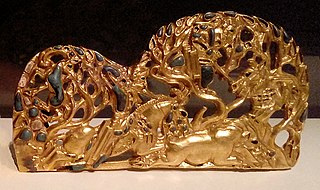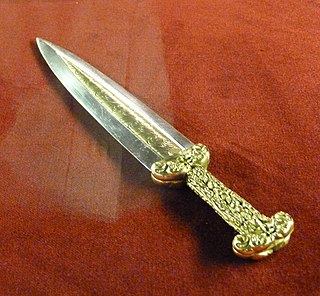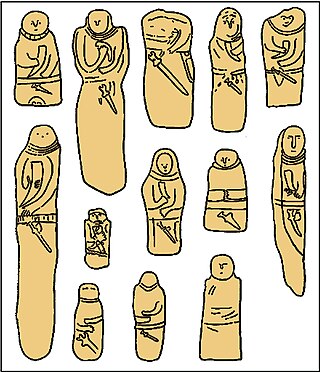Madius may refer to:
- Madius the Scythian (c. 658/9–625 BCE), Scythian king
- Madius (fl. 986), the founder of the Madi family
- Madius (bishop) (died after 1358), Catholic prelate
- Madius Tangau (born 1958), Malaysian politician
Madius may refer to:

The Scythians or Scyths, and sometimes also referred to as the Classical Scythians and the Pontic Scythians, were an ancient Eastern Iranian equestrian nomadic people who had migrated from Central Asia to the Pontic Steppe in modern-day Ukraine and Southern Russia from approximately the 7th century BC until the 3rd century BC.
The Indo-Parthian Kingdom was a Parthian kingdom founded by Gondophares, and active from 19 CE to c. 226 CE. At their zenith, they ruled an area covering parts of eastern Iran, various parts of Afghanistan and the northwest regions of the Indian subcontinent. The rulers may have been members of the House of Suren, and the kingdom has even been called the "Suren Kingdom" by some authors.

Indo-Scythians were a group of nomadic Iranian peoples of Scythian origin who migrated from Central Asia southward into modern day Afghanistan, Pakistan and Northwestern India from the middle of the 2nd century BCE to the 4th century CE.

The Scythian languages are a group of Eastern Iranian languages of the classical and late antique period, spoken in a vast region of Eurasia by the populations belonging to the Scythian cultures and their descendants. The dominant ethnic groups among the Scythian-speakers were nomadic pastoralists of Central Asia and the Pontic–Caspian steppe. Fragments of their speech known from inscriptions and words quoted in ancient authors as well as analysis of their names indicate that it was an Indo-European language, more specifically from the Iranian group of Indo-Iranian languages.

Scythian art is the art associated with Scythian cultures, primarily decorative objects, such as jewellery, produced by the nomadic tribes of the area known as Scythia, which encompassed Central Asia, parts of Eastern Europe east of the Vistula River, and parts of South Asia, with the eastern edges of the region vaguely defined by ancient Greeks. The identities of the nomadic peoples of the steppes is often uncertain, and the term "Scythian" should often be taken loosely; the art of nomads much further east than the core Scythian territory exhibits close similarities as well as differences, and terms such as the "Scytho-Siberian world" are often used. Other Eurasian nomad peoples recognised by ancient writers, notably Herodotus, include the Massagetae, Sarmatians, and Saka, the last a name from Persian sources, while ancient Chinese sources speak of the Xiongnu or Hsiung-nu. Modern archaeologists recognise, among others, the Pazyryk, Tagar, and Aldy-Bel cultures, with the furthest east of all, the later Ordos culture a little west of Beijing. The art of these peoples is collectively known as steppes art.

The acinaces, also spelled akinakes or akinaka is a type of dagger or xiphos used mainly in the first millennium BCE in the eastern Mediterranean Basin, especially by the Medes, Scythians, Persians and Caspians, then by the Greeks.
Sindhi may refer to:

Scythia or Scythica was a kingdom created by the Scythians during the 8th to 3rd centuries BC in the Pontic–Caspian steppe.
Iranian mythology or Iranic mythology may refer to any of the following mythologies of various Iranian peoples:
Dardanus may refer to:

The Scythian religion refers to the mythology, ritual practices and beliefs of the Scythian cultures, a collection of closely related ancient Iranian peoples who inhabited Central Asia and the Pontic–Caspian steppe in Eastern Europe throughout Classical Antiquity, spoke the Scythian language, and which included the Scythians proper, the Cimmerians, the Sarmatians, the Alans, the Sindi, the Massagetae and the Saka.
In Greek mythology, Borysthenis may refer to two distinct individuals:
Kahlon is a surname. Other spellings of this name include Kahloon, Kahloun, Cahloon and Cahlon. The name has multiple origins including German, Israelí, Irish, Indo-Scythian, Hebrew, and Jat
Datuk Seri Panglima Wilfred Bumburing is a Malaysian politician. He is a member of the Sabah State Legislative Assembly and a former Member of the Parliament of Malaysia for the seat of Tuaran, Sabah (2008–2013).

Datuk Seri Panglima Wilfred Madius Tangau is a Malaysian politician who has served as the Member of Parliament (MP) for Tuaran from November 1999 to March 2008 and again since May 2013. He served as the Deputy Chief Minister and State Minister of Trade and Industry of Sabah in the Sabah Heritage Party (WARISAN) state administration from May 2018 to the collapse of the WARISAN administration in September 2020, Minister of Science, Technology and Innovation from July 2015 to May 2018. He is a member of the United Progressive Kinabalu Organisation (UPKO), a component party of the PH coalition. He has served as the Honorary President of UPKO since January 2023, 2nd President of UPKO from March 2014 to January 2023, when he served in the official capacity from September 2018 to January 2023 and acting capacity from March 2014 following the resignation of Bernard Giluk Dompok to his official assumption of UPKO presidency in September 2018.

Paerisades V was the son of Paerisades III and Kamasarye Philoteknos. He was last Spartocid ruler of the Bosporan Kingdom and ruled from 125 to c. 109 BC after the death of his brother Paerisades IV Philometor. With his death, ended a dynasty of Bosporan kings that had ruled the Bosporan Kingdom for over 3 centuries, starting in 438 BC with his ancestor Spartokos I.
Scythians were an ancient Iranian people of the Pontic steppe.
Scythia was an ancient kingdom founded by the Scythians in antiquity.

The Scythian archers were a hypothesized police force of 5th- and early 4th-century BC Athens that is recorded in some Greek artworks and literature. The force is said to have consisted of 300 armed Scythians who were public slaves in Athens. They acted for a group of eleven elected Athenian magistrates "who were responsible for arrests and executions and for some aspects of public order" in the city. Despite being called "archers", the Scythian police probably did not use bows and arrows.
Spargapeithes was the name of a number of kings of various peoples belonging to Scythian cultures.